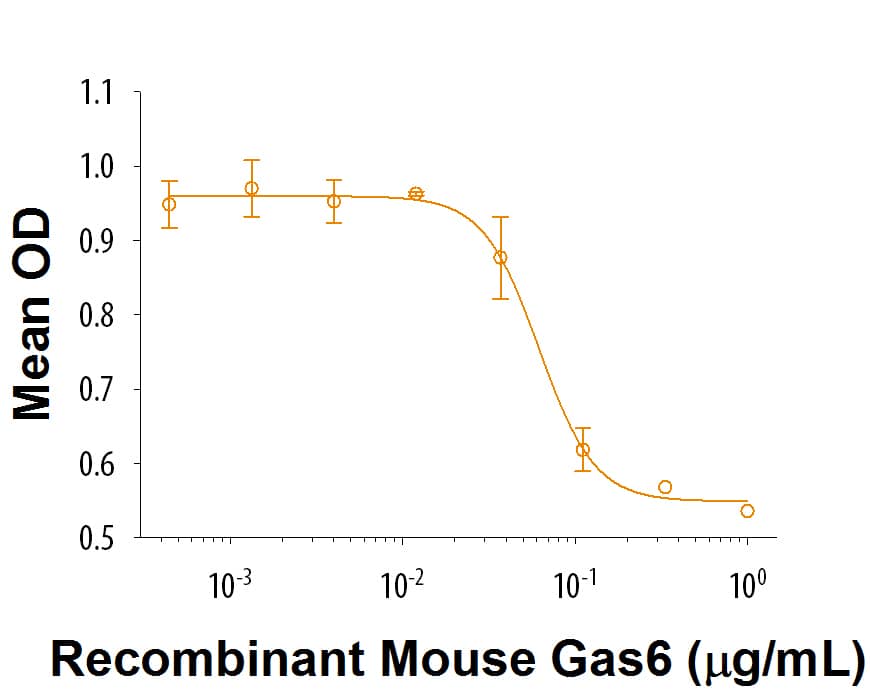Recombinant Mouse Gas6 (Full Length) Protein, CF
R&D Systems, part of Bio-Techne | Catalog # 8310-GS

Key Product Details
Product Specifications
Source
Mouse myeloma cell line, NS0-derived mouse Gas6 protein
Ala46-Pro673, with a C-terminal 6-His tag
Ala46-Pro673, with a C-terminal 6-His tag
Purity
>95%, by SDS-PAGE visualized with Silver Staining and quantitative densitometry by Coomassie® Blue Staining.
Endotoxin Level
<0.10 EU per 1 μg of the protein by the LAL method.
N-terminal Sequence Analysis
Ala46 & Tyr47
Predicted Molecular Mass
71 kDa
SDS-PAGE
78-94 kDa, reducing conditions
Activity
Measured by its ability to down regulate the expression of Axl in DU145 human prostate carcinoma cells. Mishra, A. et al. (2012) Mol. Cancer Res. 10:703.
The ED50 for this effect is 20-100 ng/mL.
The ED50 for this effect is 20-100 ng/mL.
Reviewed Applications
Read 1 review rated 4 using 8310-GS in the following applications:
Scientific Data Images for Recombinant Mouse Gas6 (Full Length) Protein, CF
Recombinant Mouse Gas6 (Full Length) Protein Bioactivity
Recombinant Mouse Gas6 (Catalog # 8310-GS) down regulates the expression of Axl in DU145 human prostate carcinoma cells. The ED50 for this effect is 20-100 ng/mL.Recombinant Mouse Gas6 (Full Length) Protein SDS-PAGE
1 μg/lane of Recombinant Mouse Gas6 (Full Length, Catalog # 8310-GS) was resolved with SDS-PAGE under reducing (R) and non-reducing (NR) conditions and visualized by silver staining, showing R bands at 85.4 and 69.2 kDa and NR band at 64.4 kDa.Formulation, Preparation and Storage
8310-GS
| Formulation | Lyophilized from a 0.2 μm filtered solution in PBS. |
| Reconstitution |
Reconstitute at 250 μg/mL in sterile PBS.
|
| Shipping | The product is shipped at ambient temperature. Upon receipt, store it immediately at the temperature recommended below. |
| Stability & Storage | Use a manual defrost freezer and avoid repeated freeze-thaw cycles.
|
Background: Gas6
References
- Laurance, S. et al. (2012) Adv. Nutr. 3:196.
- Manfioletti, G. et al. (1993) Mol. Cell Biol. 13:4976.
- Nagata, K. et al. (1996) J. Biol. Chem. 271:30022.
- Sather, S. et al. (2007) Blood 109:1026.
- Ekman, C. et al. (2010) J. Thromb. Haemost. 8:838.
- Hasanbasic, I. et al. (2005) J. Thromb. Haemost. 3:2790.
- Morizono, K. et al. (2011) Cell Host Microbe 9:286.
- Gould, W.R. et al. (2005) J. Thromb. Haemost. 3:733.
- Robins, R.S. et al. (2012) Blood 121:692.
- Alciato, F. et al. (2010) J. Leukoc. Biol. 87:869.
- Stenhoff, J. et al. (2004) Biochem. Biophys. Res. Commun. 319:871.
- Li, R. et al. (1996) J. Neurosci. 16:2012.
- Nakano, T. et al. (1995) J. Biol. Chem. 270:5702.
- Caraux, A. et al. (2006) Nat. Immunol. 7:747.
- Gallicchio, M. et al. (2005) Blood 105:1970.
- Loges, S. et al. (2010) Blood 115:2264.
- Gustafsson, A. et al. (2009) PLoS ONE 4:e7575.
Long Name
Growth-arrest-specific Protein 6
Alternate Names
AXLLG
Gene Symbol
GAS6
UniProt
Additional Gas6 Products
Product Documents for Recombinant Mouse Gas6 (Full Length) Protein, CF
Product Specific Notices for Recombinant Mouse Gas6 (Full Length) Protein, CF
For research use only
